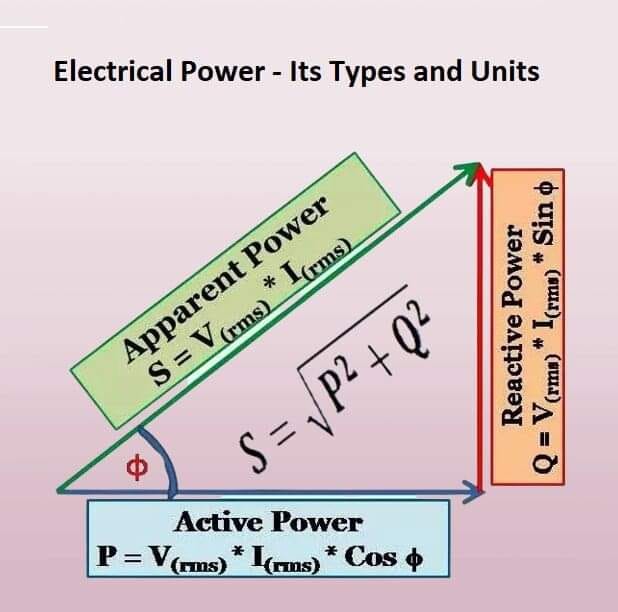Electrical Power – Its Types and Units
Introduction
Electrical power is a fundamental concept that plays a pivotal role in modern society. From lighting our homes to powering vast industries, electrical power has become an indispensable part of our daily lives. In this article, we will explore what electrical power is, delve into its different types, and understand the units used to measure it.
What is Electrical Power?
Electrical power refers to the rate at which electrical energy is transferred or converted from one form to another. In simpler terms, it is the amount of work done or energy consumed per unit of time. The flow of electric current through a circuit generates power, which is then used to perform various tasks, such as running electronic devices, appliances, and machinery.
The unit of electrical power is the watt, symbolized by the letter “W.” One watt is equivalent to the consumption or generation of one joule of energy per second. The higher the wattage of a device or electrical system, the more power it can handle or consume.

Types of Electrical Power
Electrical power can be categorized into two types based on the nature of electrical current flow:
- Direct Current (DC): Direct Current (DC) flows in a single direction through a circuit and maintains a constant voltage level over time. It is commonly used in batteries, electronic devices, and small-scale applications.
- Alternating Current (AC): Alternating Current (AC) periodically changes direction, constantly reversing its flow. AC power is the standard form of electricity used in most homes, businesses, and industries. It allows for efficient long-distance transmission and is generated and distributed by power plants through electrical grids.
Apparent Power: Apparent power is the combination of real power and reactive power in an AC circuit. It is measured in volt-amperes (VA) and represents the total power supplied to a circuit, including both useful and non-useful power components.
Active or Real Power: Active or real power is the portion of apparent power that performs useful work and is measured in watts (W). It is the power that actually does the work, such as providing light, heat, or mechanical output in a circuit.
Reactive Power: Reactive power is the portion of apparent power that does not perform useful work but is necessary to maintain voltage stability in an AC system. It is measured in volt-amperes reactive (VAR) and is required for the magnetization of motors and transformers.
Relation between Apparent, Active & Reactive Power: The relationship between apparent, active, and reactive power is given by the power factor. Power factor is the ratio of active power to apparent power and is expressed as a value between 0 and 1, or as a percentage between 0% and 100%. A power factor of 1 (or 100%) indicates that all the power is active and performing useful work, while a power factor less than 1 indicates the presence of reactive power and possible energy inefficiencies in the circuit.
Units of Electrical Power
- Watt (W): The watt is the standard unit of electrical power and is used to measure the rate of energy transfer or consumption. One watt is equal to one joule per second.
- Kilowatt (kW): Since wattage values can vary widely, kilowatts are commonly used to represent larger amounts of electrical power. One kilowatt is equal to 1,000 watts.
- Megawatt (MW): Megawatts are used to measure power on a much larger scale, such as in power plants or large industrial facilities. One megawatt is equal to 1,000 kilowatts or 1 million watts.
- Gigawatt (GW): Gigawatts are used for even larger applications, such as national power generation. One gigawatt is equal to 1,000 megawatts or 1 billion watts.
Power Factor
Power factor is an important concept related to electrical power, especially in AC circuits. It is the ratio of real power (in watts) to apparent power (in volt-amperes). Power factor is a measure of how effectively electrical power is being used in a circuit. A power factor of 1 (or 100%) means all the power is being used efficiently, while a power factor less than 1 indicates a portion of the power is being lost due to reactive components. Low power factors can result in energy wastage and lead to additional costs for utilities and consumers.
Maximum Demand and Load Factor
Maximum demand refers to the peak power consumption of an electrical system during a specific period, usually measured in kilowatts (kW). Understanding the maximum demand helps utilities plan for capacity requirements and avoid power outages during periods of high demand.
Load factor, on the other hand, is the ratio of the average power demand to the maximum demand over a certain period, typically a month or a year. A high load factor signifies a steady and efficient utilization of electrical power, while a low load factor indicates varying and inefficient consumption patterns.
Power Losses
During the transmission and distribution of electrical power, energy losses occur due to resistance in wires and other components. These losses are typically in the form of heat and can be minimized by using thicker conductors, better insulation, and more efficient transformers. Reducing power losses is crucial to ensure a reliable and cost-effective electricity supply.
Renewable Energy and Power Generation
The concept of electrical power is closely linked to various methods of power generation. Traditional methods include thermal power plants (burning fossil fuels), nuclear power plants (splitting atoms), and hydroelectric power plants (generating electricity from flowing water). However, there is a growing emphasis on renewable energy sources like solar, wind, geothermal, and biomass. These sustainable options aim to reduce greenhouse gas emissions and combat climate change.
FAQs
What is electrical power?
Electrical power refers to the rate at which electrical energy is transferred or converted from one form to another.
What are the types of electrical power?
There are two main types: Direct Current (DC) and Alternating Current (AC).
What units are used to measure electrical power?
Electrical power is measured in watts (W), kilowatts (kW), megawatts (MW), and gigawatts (GW).
How does AC power differ from DC power?
AC power periodically changes direction, while DC power flows in a single direction.
What is power factor?
Power factor is the ratio of real power to apparent power in an AC circuit, indicating its efficiency.
What is renewable energy?
Renewable energy comes from sustainable sources like solar, wind, and hydroelectric power.
What is a smart grid?
A smart grid is an advanced electricity network with real-time monitoring and optimization capabilities.
How do power electronics work?
Power electronics use semiconductor devices to modify voltage, current, and frequency of electric power.
Why is reducing power loss important?
Reducing power loss improves energy efficiency and lowers electricity costs.
How can demand response benefit consumers?
Demand response allows consumers to adjust their electricity usage based on price signals, saving money and supporting grid stability.
Conclusion
In conclusion, electrical power is a multifaceted concept that underpins our modern way of life. It comes in various forms, from direct current to alternating current, and is measured in units like watts, kilowatts, megawatts, and gigawatts. Understanding electrical power, its types, and the units of measurement helps us appreciate the significance of electricity in our lives. From the smallest electronic gadget to the largest power plants, electrical power plays a critical role in powering our technologically advanced world. As we continue to advance and innovate, a deeper understanding of electrical power will undoubtedly lead to more efficient and sustainable energy solutions for the future.
 Electrical Engineering World Wiring a Brighter Tomorrow!
Electrical Engineering World Wiring a Brighter Tomorrow!


